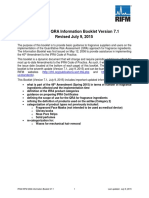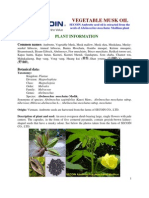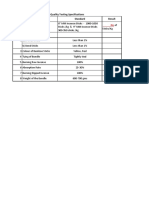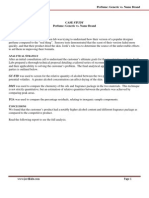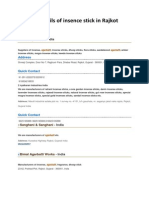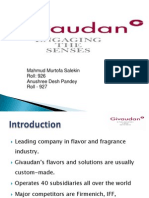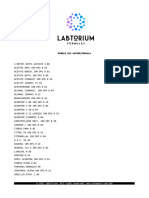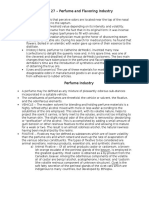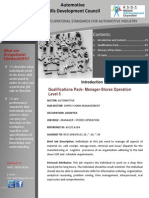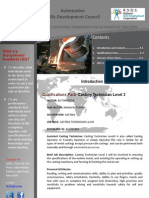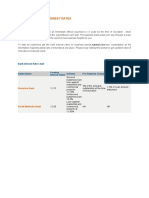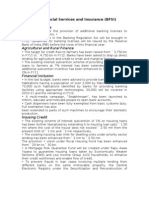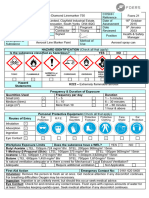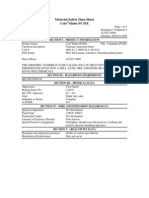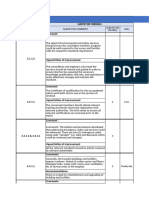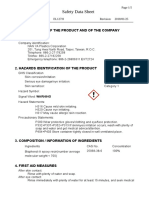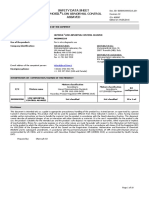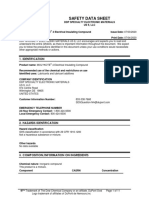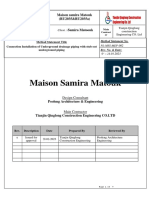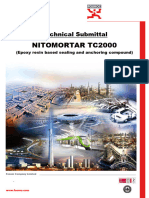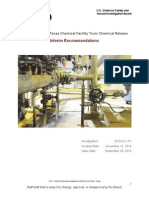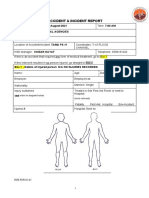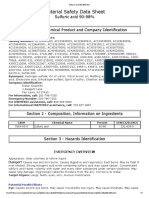Perfume Applicator
Perfume Applicator
Uploaded by
kaushik638Copyright:
Available Formats
Perfume Applicator
Perfume Applicator
Uploaded by
kaushik638Original Description:
Copyright
Available Formats
Share this document
Did you find this document useful?
Is this content inappropriate?
Copyright:
Available Formats
Perfume Applicator
Perfume Applicator
Uploaded by
kaushik638Copyright:
Available Formats
QUALIFICATIONS PACK - OCCUPATIONAL STANDARDS FOR
HANDICRAFTS AND CARPET SECTOR
Contents
1. Introduction and Contacts......P.1
What are
Occupational
Standards(OS)?
OS describe what
individuals need
to do, know and
understand in
order to carry out
a particular job
role or function
OS are
performance
standards that
individuals must
achieve when
carrying out
functions in the
workplace,
together with
specifications of
the underpinning
knowledge and
understanding
Contact Us:
Handicrafts & Carpet
Sector Skill Council
(HCSSC),
EPCH House,
Pocket 6 & 7, Sector C,
Vasant Kunj,
New Delhi-110070
E-mail:
hcssc@hcssc.in
2. Qualifications Pack...........P.2
3. Glossary of Key Terms........P.3
4. NOS Units..P.5
5. Annexure: Nomenclature for QP & OS.P.29
6. Assessment Criteria.P.31
Introduction
Qualifications Pack- Agarbatti Perfume Applicator
SECTOR: HANDICRAFTS AND CARPET
SUB-SECTOR: Handicrafts (Agarbatti)
OCCUPATION: Agarbatti Perfume Applicator
REFERENCE ID: HCS/Q 8001
ALIGNED TO: NCO-2004/8229.202
Brief Job Description: Agarbatti Perfume Applicator is the one who prepares the
perfume solution and carries out perfuming of raw Agarbattis by dipping in the
Ready- to- Dip perfume solution and
Personal Attributes: Perfume Applicator should have good eyesight, hand-eye
coordination, motor skills and vision (including near vision, distance vision,
colour vision, peripheral vision, depth perception and ability to change focus).
Qualifications Pack For Agarbatti Perfume Applicator
HCS/Q 8001
Job Details
Qualifications Pack Code
Job Role
AGARBATTI PERFUME APPLICATOR
Credits(NSQF)
Sector
Sub-sector
TBD
Handicrafts & Carpet
Handicrafts (Agarbatti)
Version number
Drafted on
Last reviewed on
1.0
19/06/15
29/06/15
Occupation
Agarbatti Perfume
Applicator
Next review date
29/06/17
Job Role
Agarbatti Perfume Applicator
Training
(Suggested but not mandatory)
Minimum Job Entry Age
Agarbatti Perfume Applicator is the one who prepares the
perfume solution and carries out perfuming of raw Agarbattis
by dipping in a Ready- to- Dip solution.
3
Preferably 5th standard
Not Applicable
Training in preparation of RTD (Ready- to- Dip) solution and
carrying out perfuming by dipping.
15 years
Experience
Not Applicable
Role Description
NSQF level
Minimum Educational Qualifications
Maximum Educational Qualifications
Compulsory:
Applicable National Occupational
Standards (NOS)
Performance Criteria
1. HCS/N 8001 (Prepration of Ready-to-Dip solution for
perfuming raw agarbatti sticks)
2. HCS/N 8002 (Carry out absorption by dipping in RTD
solution)
3. HCS/N 8003 (Contribute to achieve quality in perfuming
of raw agarbattis)
4. HCS/N 9908 (Working in a team)
5. HCS/N 9912 (Maintain work area and tools)
6. HCS/N 9913 (Maintain health, safety and security at
workplace)
Optional:
N/A
As described in the relevant OS units
Qualifications Pack For Agarbatti Perfume Applicator
Qualifications Pack For Agarbatti Perfume Applicator
Glossary of Key Terms
Definitions
Keywords /Terms
Sector
Sub-sector
Vertical
Occupation
Function
Sub-functions
Job role
Occupational
Standards (OS)
Performance
Criteria
National
Occupational
Standards (NOS)
Qualifications Pack
Code
Qualifications
Pack(QP)
Unit Code
Unit Title
Description
Description
Sector is a conglomeration of different business operations having similar
businesses and interests. It may also be defined asa distinct subset of the
economy whose components share similar characteristics and interests.
Sub-sector is derived from a further breakdown based on the
characteristics and interests of its components.
Vertical may exist within a sub-sector representing different domain areas
or the client industries served by the industry.
Occupation is a set of job roles, which perform similar/related set of
functions in an industry.
Function is an activity necessary for achieving the key purpose of the
sector, occupation, or area of work, which can be carried out by a person
or a group of persons. Functions are identified through functional analysis
and form the basis of OS.
Sub-functions are sub-activities essential to fulfill the achieving the
objectives of the function.
Job role defines a unique set of functions that together form a unique
employment opportunity in an organization.
OS specify the standards of performance an individual must achieve when
carrying out a function in the workplace, together with the knowledge and
understanding they need to meet that standard consistently.
Occupational Standards are applicable both in the Indian and global
contexts.
Performance Criteria are statements that together specify the standard of
performance required when carrying out a task.
NOS are Occupational Standards which apply uniquely in the Indian
context.
Qualifications Pack Code is a unique reference code that identifies a
qualifications pack.
Qualifications Pack comprises the set of OS, together with the
educational, training and other criteria required to perform a job role. A
Qualifications Pack is assigned a unique qualification pack code.
Unit Code is a unique identifier for an OS unit, which can be denoted with
either an O or an N.
Unit Title gives a clear overall statement about what the incumbent
should be able to do.
Description gives a short summary of the unit content. This would be
4
Qualifications Pack For Agarbatti Perfume Applicator
Scope
Knowledge and
Understanding
Organizational
Context
Technical
Knowledge
Core Skills/Generic
Skills
Acronyms
Helpdesk
helpful to anyone searching on a database to verify that this is the
appropriate OS they are looking for.
Scope is the set of statements specifying the range of variables that an
individual may have to deal with in carrying out the function which have a
critical impact on the quality of performance required.
Knowledge and Understanding are statements which together specify the
technical, generic, professional and organizational specific knowledge that
an individual needs in order to perform to the required standard.
Organizational Context includes the way the organization is structured
and how it operates, including the extent of operative knowledge
managers have of their relevant areas of responsibility.
Technical Knowledge is the specific knowledge needed to accomplish
specific designated responsibilities.
Core Skills or Generic Skills are a group of skills that are key to learning
and working in today's world. These skills are typically needed in any work
environment. In the context of the OS , these include communication
related skills that are applicable to most job roles.
Helpdesk is an entity to which the customers will report their IT problems.
IT Service Helpdesk Attendant is responsible for managing the helpdesk.
Keywords /Terms
Description
SSC
Sector Skill Council
OS
Occupational Standard(s)
NOS
National Occupational Standard(s)
QP
Qualifications Pack
UGC
University Grants Commission
MHRD
Ministry of Human Resource Development
MoLE
Ministry of Labor and Employment
NVQF
National Vocational Qualifications Framework
HCSSC
Handicrafts and Carpet Sector Skill Council
TBD
To Be Determined
NSDC
National Skill Development Corporation
M/C
Machine
HCS/N 8001
Preparation of Ready- to- Dip (RTD) perfume solution for raw agarbattis
----------------------------------------------------------------------------------------------------------------------------- ---------------
National Occupational
Standard
Overview
This unit is about preparation of Ready-to-Dip (RTD) perfume solution which is used for
perfuming raw agarbattis by dipping technique.
National Occupational Standard
HCS/N 8001
Unit Code
Unit Title
(Task)
Description
Preparation of Ready- to- Dip (RTD) perfume solution for raw agarbattis
HCS/N 8001
To prepare the Ready-to-Dip (RTD) solution for perfuming the raw agarbattis.
This unit is about to carry out basic operations for making RTD solution for perfuming
raw agarbattis.
Scope
Basic operations to be undertaken by the Perfume Applicator are as follows:
to determine the optimum amount of ready concentrated perfume & fixative
solvent required
to mix the appropriate quantity of ingredients required to make the ready- todip solution based on the batch size.
Performance Criteria (PC) w.r.t. the Scope
To determine the
To be competent, the user/individual on the job must be able to:
optimum amount of
PC1. identify the appropriate perfume concentrate
ready concentrated
PC2. identify the correct set of ingredients for the required set
perfume & fixative
PC3. analyze the agarbatti batch size for perfuming for estimating the amount of
solvent required
rtd required
PC4. determine the appropriate ratio of mixing of concentrated perfume and
fixative solvent (such as di-ethyl phathalate)
PC5. determine the amount of concentrated perfume solution for the required
quality of agarbatti
PC6. use the appropriate containers & measuring jars
PC7. ensure minimum wastage of concentrated perfume and other liquids
PC8. avoid contamination of solutions and concentrates while measuring and
mixing
To mix the appropriate
PC9. ensure uniform mixing of ingredients
quantity of ingredients
PC10. ensure and maintain the correct proportion of ingredients
required to make the
PC11. use the solution appropriately to avoid mistakes
Ready- to- Dip solution
PC12. store the solution appropriately to avoid loss due to evaporation
based on the batch size
PC13. determine the retention time of scent & fixative solvent mixture for uniform
mixing
PC14. take safety precautions while handling the perfume and chemicals
PC15. respond appropriately in case of any major faults in the ingredients
PC16. minimise and dispose the waste materials in the approved manner
PC17. leave work area safe and secure when work is complete
PC18. carry out the work at a rate that maintains work flow
Knowledge and Understanding (K)
A. Organizational
The user/individual needs to know and understand:
Context
KA1. the organizations policies, procedures, guidelines and standards for quality
(Knowledge of
KA2. safe working practices and organisational procedures
the company/
KA3. quality systems and other processes practiced in the organization
organization and
KA4. types of problems with quality and how to report them to appropriate people
its processes)
KA5. the importance of complying with written instructions
KA6. reporting procedure in case of faults in own/ other processes
KA7. whom to refer problems to when they are outside the limit of your authority
7
HCS/N 8001
Preparation of Ready- to- Dip (RTD) perfume solution for raw agarbattis
B. Technical
Knowledge
Skills (S)
A. Core Skills/
Generic Skills
B. Professional Skills
KA8. your organizations tools, templates and processes for related operations in
production
The user/individual needs to know and understand:
KB1. about different types of perfumes available and their identifying feature
KB2. about fixative solvent and their use
KB3. step-by-step process of making the rtd solution
KB4. the correct use of the equipments used for preparing the solution
Writing Skills
The user/individual needs to know and understand how to:
SA1. write in local language
Reading Skills
The user/individual need to know and understand how to:
SA2. read measurement instructions.
Oral Communication (Listening and Speaking skills)
The user/individual needs to know and understand how to:
SA3. listen effectively and orally communicate information accurately
SA4. ask for clarification and advice from others
Decision Making
The The user/individual on the job needs to know and understand how to:
SB1. follow organization rule-based decision making process
SB2. take decision with systematic course of actions and/or response
Plan and Organize
User/individual needs to know and understand how to:
SB3. plan and organize your work to achieve targets and deadlines
Customer Centricity
The user/individual on the job needs to know and understand how to:
SB4. manage relationships with customers
SB5. build customer relationships and use customer centric approach
Problem Solving
User/individual needs to know and understand how to:
SB6. think through the problem, evaluate the possible solution(s) and suggest an
optimum /best possible solution(s)
SB7. identify immediate or temporary solutions to resolve delays
Analytical Thinking
User/individual needs to know and understand how to:
SB8. analyze data and activities
SB9. pass on relevant information to others
Critical Thinking
User/individual need to know and understand how to:
SB10. apply, analyze, and evaluate the information gathered from observation,
experience, reasoning, or communication, as a guide to thought and action
HCS/N 8001
Preparation of Ready- to- Dip (RTD) perfume solution for raw agarbattis
NOS Version Control
HCS/N 8001
NOS Code
Credits (NSQF)
Industry
Industry Sub-sector
Occupation
TBD
Handicraft and Carpet
Sector
Handicraft (Agarbatti)
Agarbatti Perfume
Applicator
Version number
1.0
Drafted on
19/06/15
Last reviewed on
29/06/15
Next review date
29/06/17
HCS/N 8002
Carry out absorption by dipping in RTD solution
----------------------------------------------------------------------------------------------------------------------------- ---------------
National Occupational
Standard
Overview
This unit is about carrying out the process of applying perfume on raw agarbattis by dipping
in RTD solution.
10
National Occupational Standard
HCS/N 8002
Unit Code
Unit Title
(Task)
Description
Carry out absorption by dipping in RTD solution
HCS/N 8002
Carry out absorption by dipping in RTD solution
This unit provides Performance Criteria, Knowledge & Understanding and Skills &
Abilities required to carry out absorption by dipping in RTD solution.
Scope
Basic operations to be undertaken by the Perfume Applicator are as follows:
to carry out dipping in ready-to-dip solution.
to carry out complete absorption of solution into agarbatti sticks.
Performance Criteria (PC) w.r.t. the Scope
To carry out dipping
To be competent on the job, the user/individual on the job must be able to:
in Ready-to-Dip
PC1. check & ensure that the dipping area is free from dirt & hazardous material
solution.
PC2. ensure that the equipments, tools and hands are cleaned properly to avoid
any contamination that may occur from previous batch of perfuming
PC3. carry out dipping of agarbatti according to the standards
PC4. ensure optimum absorption
PC5. carry out process in the given time frame
PC6. ensure minimal wastage of solution
PC7. appropriately use the hand gloves for handling the sticks to avoid wastage of
solution
PC8. ensure total absorption of solution in agrabatti stick
PC9. take safety measure while working with solutions
PC10. ensure that agarbatti sticks bundle is properly placed in the area after
dipping where it can absorb the solution without any disturbance
To carry out
PC11. properly keep the dipped agarbattis in an enclosure to ensure proper
complete absorption
absorption
of perfume into
PC12. ensure minimum loss of perfume solution due to evaporation
agarbatti stick
PC13. ensure that the agarbattis are retained in the enclosure for optimum time
PC14. ensure that the perfume spilled in the dipping tray be collected for reuse
PC15. report to the instructor in case of undesirable smell of fragrance
PC16. carry out the work at a rate that maintains workflow for the next level of
processing
Knowledge and Understanding (K)
A. Organizational
The user/individual needs to know and understand:
Context
KA1. the organisations policies and procedures
(Knowledge of the
KA2. responsibilities under health, safety and environmental legislation
company/
KA3. guidelines for storage and disposal of waste materials
organization and
KA4. protocol to obtain more information on work related tasks
its processes)
KA5. contact person in case of queries on procedure or for resolving issues
related to defective tools and/or equipment
KA6. details of the job role and responsibilities
KA7. work target and review mechanism with your supervisor
KA8. protocol and format for reporting work related risks/ problems
KA9. method of obtaining/ giving feedback related to performance
KA10. importance of team work and harmonious working relationships
11
HCS/N 8002
B. Technical
Knowledge
Skills (S)
A. Core Skills/
Generic Skills
B. Professional Skills
Carry out absorption by dipping in RTD solution
KA11. process for offering/ obtaining work related assistance
The user/individual needs to know and understand:
KB1. perfuming by absorption method (by dipping)
KB2. steps involved in perfuming by dipping
KB3. need for optimizing the absorption level
KB4. cause & consequences of contamination of fragrance
KB5. common hazards in the work area and workplace procedures for dealing
with them
Writing Skills
The user/individual on the job needs to know and understand how to:
SA1. write in local language
Reading Skills
The user/individual on the job needs to know and understand how to:
SA2. read measurement instructions.
Oral Communication (Listening and Speaking skills)
The user/individual on the job needs to know and understand how to:
SA3. listen effectively and orally communicate information accurately
SA4. ask for clarification and advice from others
Decision Making
The The user/individual on the job needs to know and understand how to:
SB1. follow organization rule-based decision making process
SB2. take decision with systematic course of actions and/or response
Plan and Organize
User/individual needs to know and understand how to:
SB3. plan and organize your work to achieve targets and deadlines
Customer Centricity
The user/individual on the job needs to know and understand how to:
SB4. manage relationships with customers
SB5. build customer relationships and use customer centric approach
Problem Solving
User/individual needs to know and understand how to:
SB6. think through the problem, evaluate the possible solution(s) and suggest an
optimum /best possible solution(s)
SB7. identify immediate or temporary solutions to resolve delays
Analytical Thinking
User/individual needs to know and understand how to:
SB8. analyze data and activities
SB9. pass on relevant information to others
Critical Thinking
User/individual need to know and understand how to:
SB10. apply, analyze, and evaluate the information gathered from observation,
experience, reasoning, or communication, as a guide to thought and action
12
HCS/N 8002
Carry out absorption by dipping in RTD solution
NOS Version Control
HCS/N 8002
NOS Code
Credits (NSQF)
Industry
Industry Sub-sector
Occupation
TBD
Handicraft and carpet
sector
Handicraft (Agarbatti)
Agarbatti Perfume
Applicator
Version number
1.0
Drafted on
19/06/15
Last reviewed on
29/06/15
Next review date
29/06/17
13
HCS/N 8003
Contribute to achieve quality in perfuming of raw agarbattis
----------------------------------------------------------------------------------------------------------------------------- ---------------
National Occupational
Standard
Overview
This unit provides Performance Criteria, Knowledge & Understanding and Skills & abilities
required to achieve quality in perfuming of raw Agarbattis
14
National Occupational Standard
HCS/N 8003
Contribute to achieve quality in perfuming of raw agarbattis
Unit Code
Unit Title (Task)
Description
HCS/N 8003
Contribute to achieve quality in perfuming of raw agarbattis
This unit provides Performance Criteria, Knowledge & Understanding and Skills &
Abilities required to achieve quality in perfuming of raw Agarbattis
Scope
This unit/task covers the following:
achieving the quality in perfuming of raw agarbattis and related operations
Performance Criteria (PC) w.r.t the Scope
Elements
Performance Criteria
Contribute to
To be competent, the user/individual on the job must be able to:
achieving the
PC1. identify and use raw agarbattis as per the specifications provided
product quality in PC2. ensure that the raw agarbatti lot used for perfuming comply to quality
perfuming of raw
standards
agarbattis
PC3. ensure that the correct concentration of perfume solution is identified
PC4. take the necessary action if the s o l u t i o n does not confirm to quality
standards
PC5. ensure the dipping of agarbatti is done for optimum time
PC6. conduct burning test for the agarbatti batches to ensure optimum burning
consistency and time
PC7. ensure that the absorption content is about 15%
PC8. carry out work safely and at a rate which maintains work flow
PC9. carry out quality checks at specified intervals according to instructions
PC10. report to the responsible person when the work flow of other production
areas disrupts work
PC11. apply the allowed tolerances
PC12. identify and segregate faulty agarbattis/ agarbatti lots
PC13. ensure the intensity of fragrance is as desired
Knowledge and Understanding (K) w.r.t. the Scope
Elements
Knowledge and Understanding
A. Organisational The user/individual on the job needs to know and understand:
Context
KA1. safe working practices and organisational procedures
(Knowledge of the KA2. the organisation's procedures and guidelines
company /
KA3. quality systems
organisation and its KA4. equipment operating procedures / manufacturers instructions
processes)
KA5. types of problems with quality and how to report them to appropriate
people
KA6. methods to present any ideas for improvement to supervisor
KA7. the importance of complying with written instructions
KA8. limits of personal responsibility
KA9. reporting procedure in case of faults in own/ other processes
15
HCS/N 8003
Contribute to achieve quality in perfuming of raw agarbattis
B. Technical /
Domain
Knowledge
National Occupational Standard
The user/individual on the job needs to know and understand:
KB1. different types of faults that are likely to be found
KB2. consequences of using incorrect tools
KB3. consequences of incorrect handling of tools
KB4. types of faults which may occur, how they are identified and methods to
deal with it
KB5. different types of defects
KB6. the importance of segregating rejects
KB7. appropriate inspection methods that can be used
KB8. different quality parameters in the industry
KB9. own responsibilities at work
Skills (S) w.r.t the Scope
Elements
Skills
A. Core Skills/
Writing Skills
Generic Skills
The user/individual on the job needs to know and understand how to:
SA1. write in local language
Reading Skills
The user/individual on the job needs to know and understand how to:
SA2. read measurement instructions.
Oral Communication (Listening and Speaking skills)
The user/individual on the job needs to know and understand how to:
SA3. listen effectively and orally communicate information accurately
SA4. ask for clarification and advice from others
B. Professional
Decision Making
Skills
The The user/individual on the job needs to know and understand how to:
SB1. follow organization rule-based decision making process
SB2. take decision with systematic course of actions and/or response
Plan and Organize
User/individual needs to know and understand how to:
SB3. Plan and organize your work to achieve targets and deadlines
Customer Centricity
The user/individual on the job needs to know and understand how to:
SB4. manage relationships with customers
SB5. build customer relationships and use customer centric approach
Problem Solving
User/individual needs to know and understand how to:
SB6. think through the problem, evaluate the possible solution(s) and suggest an
optimum /best possible solution(s)
SB7. identify immediate or temporary solutions to resolve delays
Analytical Thinking
User/individual needs to know and understand how to:
SB8. analyze data and activities
SB9. pass on relevant information to others
16
HCS/N 8003
Contribute to achieve quality in perfuming of raw agarbattis
Critical Thinking
User/individual need to know and understand how to:
SB10. apply, analyze, and evaluate the information gathered from observation,
experience, reasoning, or communication, as a guide to thought and action
NOS Version Control
HCS/N 8003
NOS Code
Credits (NSQF)
Industry
Industry Sub-sector
Occupation
TBD
Handicrafts and Carpet
Sector
Handicrafts (Agarbatti)
Agarbatti Perfume
Applicator
Version number
1.0
Drafted on
19/06/15
Last reviewed on
29/06/15
Next review date
29/06/17
17
HCS/N 9908
Working in a team
----------------------------------------------------------------------------------------------------------------------------- ----------
National Occupational
Standard
Overview
This unit is about working as part of a team within the organisation.
18
National Occupational Standard
HCS/N 9908
Unit Code
Unit Title
(Task)
Description
Scope
Working in a team
HCS/N9908
Working in a team
This unit is about working as a team member within the organisation
Commitment and trust
Communication
Adaptability
Creative freedom
Performance Criteria (PC) w.r.t. the Scope
Elements
Performance Criteria
Commitment and
PC1. be accountable to ones own role in whole process of developing product
trust
PC2. perform all roles with full responsibility
PC3. be effective and efficient at workplace
Communication
PC4. properly communicate about organization policies
PC5. talk politely with other team members and colleagues
Adaptability
PC6. adjust in different work situations
PC7. give due importance to others point of view
PC8. avoid conflicting situations
Creative freedom
PC9. develop new ideas for work procedures
PC10. improve upon the existing techniques to increase process efficiency
Knowledge and Understanding (K)
A. Organizational
KA1. general rules and regulations in a paper mache sector
Context
KA2. procedure followed to get the final output
KA3. safe working practices to be adopted
KA4. reporting to the supervisor or higher authority about any grievances faced
B. Technical
KB1. understanding the importance of the previous and next step of the process
KB2. process flow in a paper mache section
Knowledge
KB3. material sequence of flow
KB4. functions of different parts of product development
KB5. tools and equipments used
KB6. guidelines for operating the equipment
KB7. safety procedures to be followed as applicable
Skills (S)
A. Core Skills/
Writing Skills
Generic Skills
The user/individual on the job needs to know and understand:
SA1. write letters, memos, applications regarding team needs and performance in
simple language
SA2. write daily work report
Reading Skills
The user/individual on the job needs to know and understand:
SA3. comprehend written instructions
SA4. read any application sent by other colleagues and team members
Oral Communication (Listening and Speaking skills)
19
HCS/N 9908
Working in a team
The user/individual on the job needs to know and understand:
SA5. communicate with superior, colleagues and juniors appropriately
SA6. talk to team members to convey information effectively
B. Professional Skills Decision Making
The user/individual on the job needs to know and understand how to:
SB1. make decisions in relation to the concerned scope of work
Plan and Organize
The user/individual on the job needs to know and understand:
SB2. plan and organize the work to achieve shared objectives of the team
Customer Centricity
The user/individual on the job needs to know and understand how to:
SB3. manage relationships with customers who may be in need of supports to
maintain productivity and performance
SB4. build with customer a relationship of trust and cooperation in achieving team
goal
Problem Solving
The user/individual on the job needs to know and understand:
SB5. apply problem-solving approaches to resolve conflicts
SB6. seek clarification to problems when in doubt
Analytical Thinking
The user/individual on the job needs to know and understand how to:
SB7. identify root cause of problem split to utmost level of circumstances,
personality etc
Critical Thinking
The user/individual on the job needs to know and understand how to:
SB8. critically evaluate various approaches of building team and sustaining team
performance.
NOS Version Control
HCS/N9908
NOS Code
Credits (NSQF)
TBD
Version number
1.0
Industry
Handicrafts and Carpet
Handicrafts (Agarbatti)
Drafted on
19/06/15
Last reviewed on
29/06/15
Next review date
29/06/17
Industry Sub-sector
Occupation
Agarbatti Perfume
Applicator
20
HCS/N 9912
Maintain work area and tools
------------------------------------------------------------------------------------------------------------------------------------------
National Occupational
Standard
Overview
This unit provides Performance Criteria, Knowledge & Understanding and Skills & Abilities
required to organise/maintain work areas and activities to ensure tools are maintained as
per norms.
21
National Occupational Standard
HCS/N 9912
Maintain work area and tools
Unit Code
Unit Title (Task)
Description
HCS/N 9912
Maintain work area and tools
This unit provides Performance Criteria, Knowledge & Understanding and Skills &
Abilities required to organise/ maintain work areas and activities to ensure tools
and equipements used for the perfuming of raw agarbattis are maintained as per
norms.
Scope
This unit/task covers the following:
maintain the work area and tools
Performance Criteria (PC) w.r.t the Scope
Elements
Performance Criteria
Maintain the
To be competent, the user/individual on the job must be able to:
work area, tools
PC1. handle materials and tools safely and correctly
and machines
PC2. use materials to minimize waste
PC3. maintain a clean and hazard free working area
PC4. maintain the machine/tools used for bamboo stick making
PC5. carry out maintenance and/or cleaning within ones responsibility
PC6. report dameaged tools & materials
PC7. work in a comfortable position with the correct posture
PC8. dispose off waste safely in the designated location
PC9. store tools safely after use
PC10. carry out cleaning according to schedules and limits of responsibility
Knowledge and Understanding (K) w.r.t. the Scope
Elements
Knowledge and Understanding
A. Organisational The user/individual on the job needs to know and understand:
Context
KA1. personal hygiene and duty of care
(Knowledge of the KA2. safe working practices and organisational procedures
company /
KA3. limits of your own responsibility
organisation and
KA4. ways of resolving with problems within the work area
its processes)
KA5. the production process and the specific work activities that relate to the
whole process
KA6. the importance of effective communication with colleagues
KA7. the lines of communication, authority and reporting procedures
KA8. the organisations rules, codes and guidelines (including timekeeping)
KA9. the companys quality standards
KA10. the importance of complying with written instructions
B. Technical /
The user/individual on the job needs to know and understand:
Domain
KB1. work instructions and specifications accurately
Knowledge
KB2. method to make use of the information detailed in specifications and
instructions
KB3. relation between work role and the overall manufacturing process
KB4. the importance of taking action when problems are identified
KB5. different ways of minimising waste
KB6. effects of contamination on products
KB7. common faults in bamboo sticks/slivers
22
HCS/N 9912
Maintain work area and tools
KB8. tools maintenance procedures
KB9. hazards likely to be encountered when conducting routine maintenance
KB10. safe working practices for cleaning and the method of carrying them out
Skills (S) w.r.t the Scope
Elements
Skills
A. Core Skills/
Writing Skills
Generic Skills
The user/individual on the job needs to know and understand how to:
SA1. write in local language
Reading Skills
The user/individual on the job needs to know and understand how to:
SA2. read measurement instructions.
Oral Communication (Listening and Speaking skills)
The user/individual on the job needs to know and understand how to:
SA3. listen effectively and orally communicate information accurately
SA4. ask for clarification and advice from others
B. Professional
Decision Making
Skills
The The user/individual on the job needs to know and understand how to:
SB1. follow organization rule-based decision making process
SB2. take decision with systematic course of actions and/or response
Plan and Organize
User/individual needs to know and understand how to:
SB3. plan and organize your work to achieve targets and deadlines
Customer Centricity
The user/individual on the job needs to know and understand how to:
SB4. manage relationships with customers
SB5. build customer relationships and use customer centric approach
Problem Solving
User/individual needs to know and understand how to:
SB6. think through the problem, evaluate the possible solution(s) and suggest an
optimum /best possible solution(s)
SB7. identify immediate or temporary solutions to resolve delays
Analytical Thinking
User/individual needs to know and understand how to:
SB8. analyze data and activities
SB9. pass on relevant information to others
Critical Thinking
User/individual need to know and understand how to:
SB10. apply, analyze, and evaluate the information gathered from observation,
experience, reasoning, or communication, as a guide to thought and action
23
HCS/N 9912
Maintain work area and tools
NOS Version Control
HCS/N 9912
NOS Code
Credits (NSQF)
Industry
Industry Sub-sector
Occupation
TBD
Handicraft & Carpet
Sector
Handicrafts (Agarbatti)
Agarbatti Perfume
Applicator
Version number
1.0
Drafted on
19/06/15
Last reviewed on
29/06/15
Next review date
29/06/17
24
HCS/N 9913
Maintain health, safety and security at workplace
------------------------------------------------------------------------------------------------------------------------------------------
National Occupational
Standard
Overview
This unit provides Performance Criteria, Knowledge & Understanding and Skills & Abilities
required to comply with health, safety and security requirements at the workplace and
covers procedures to prevent, control and minimise risk to self and others.
25
National Occupational Standard
HCS/N 9913
Maintain health, safety and security at workplace
Unit Code
Unit Title (Task)
Description
HCS/N 9913
Maintain health, safety and security at workplace
This unit provides Performance Criteria, Knowledge & Understanding and Skills &
Abilities required to comply with health, safety and security requirements at
the workplace and covers procedures to prevent, control and minimise risk to self
and others.
Scope
This unit/task covers the following:
comply with health, safety and security requirements at work
Performance Criteria (PC) w.r.t the Scope
Elements
Performance Criteria
Comply with
To be competent, the user/individual on the job must be able to:
health, safety and PC1. comply with health and safety related instructions applicable to the
security
workplace
requirements at
PC2. use and maintain personal protective equipment as per protocol
work
PC3. carry out own activities in line with approved guidelines and procedures
PC4. maintain a healthy lifestyle and guard against dependency on intoxicants
PC5. follow environment management system related procedures
PC6. store materials and tools in line with manufacturers and organisational
requirements
PC7. safely handle and move waste and debris
PC8. minimize health and safety risks to self and others due to own actions
PC9. seek clarifications, from supervisors or other authorized personnel in case
of perceived risks
PC10. monitor the workplace and work processes for potential risks and threats
PC11. carry out periodic walk-through to keep work area free from hazards and
obstructions, if assigned
PC12. report hazards and potential risks/ threats to supervisors or other
authorized personnel
PC13. participate in mock drills/ evacuation procedures organized at the workplace
PC14. undertake first aid, fire-fighting and emergency response training, if asked
to do so
PC15. take action based on instructions in the event of fire, emergencies or
accidents
PC16. follow organisation procedures for evacuation when required
Knowledge and Understanding (K) w.r.t. the Scope
Elements
Knowledge and Understanding
A. Organisational
The user/individual on the job needs to know and understand:
Context
(Knowledge of the KA1. health and safety related practices applicable at the workplace
company /
KA2. potential hazards, risks and threats based on nature of operations
organisation and
KA3. organizational procedures for safe handling of tools
its processes)
KA4. potential risks due to own actions and methods to minimize these
KA5. environmental management system related procedures at the workplace
KA6. layout of the plant and details of emergency exits, escape routes,
26
HCS/N 9913
Maintain health, safety and security at workplace
emergency equipment and assembly points
KA7. potential accidents and emergencies and response to these scenarios
KA8. reporting protocol and documentation required
KA9. details of personnel trained in first aid, fire-fighting and emergency
response
KA10. actions to take in the event of a mock drills/ evacuation procedures or actual
accident, emergency or fire
B. Technical /
The user/individual on the job needs to know and understand:
Domain
KB1. occupational health and safety risks and methods
Knowledge
KB2. personal protective equipment and method of use
KB3. identification, handling and storage of hazardous substances
KB4. proper disposal system for waste and by-products
KB5. signage related to health and safety and their meaning
KB6. importance of sound health, hygiene and good habits
KB7. ill-effects of alcohol, tobacco and drugs
Skills (S) w.r.t the Scope
Elements
Skills
A. Core Skills/
Writing Skills
Generic Skills
The user/individual on the job needs to know and understand how to:
SA1. write in local language
Reading Skills
The user/individual on the job needs to know and understand how to:
SA2. read measurement instructions.
Oral Communication (Listening and Speaking skills)
The user/individual on the job needs to know and understand how to:
SA3. listen effectively and orally communicate information accurately
SA4. ask for clarification and advice from others
B. Professional
Decision Making
Skills
The The user/individual on the job needs to know and understand how to:
SB1. follow organization rule-based decision making process
SB2. take decision with systematic course of actions and/or response
Plan and Organize
User/individual needs to know and understand how to:
SB3. plan and organize your work to achieve targets and deadlines
Customer Centricity
The user/individual on the job needs to know and understand how to:
SB4. manage relationships with customers
SB5. build customer relationships and use customer centric approach
Problem Solving
User/individual needs to know and understand how to:
SB6. think through the problem, evaluate the possible solution(s) and suggest an
optimum /best possible solution(s)
SB7. identify immediate or temporary solutions to resolve delays
27
HCS/N 9913
Maintain health, safety and security at workplace
Analytical Thinking
User/individual needs to know and understand how to:
SB8. analyze data and activities
SB9. pass on relevant information to others
Critical Thinking
User/individual need to know and understand how to:
SB10. apply, analyze, and evaluate the information gathered from observation,
experience, reasoning, or communication, as a guide to thought and action
NOS Version Control
HCS/N 9913
NOS Code
Credits (NSQF)
Industry
Industry Sub-sector
Occupation
TBD
Handicraft & Carpet
Sector
Handicrafts (Agarbatti)
Agarbatti Perfume
Applicator
Version number
1.0
Drafted on
19/06/15
Last reviewed on
29/06/15
Next review date
29/06/17
28
Qualifications Pack For Agarbatti Perfume Applicator
Annexure
Nomenclature for QP and NOS
Qualifications Pack
9 characters
[ABC]/ Q 0101
[Insert 3 letter code for SSC]
QP number (2 numbers)
Q denoting Qualifications Pack
Occupation (2 numbers)
Occupational Standard
An example of NOS with N
9 characters
[ABC] / N 0101
[Insert 3 letter code for SSC]
OS number (2 numbers)
N denoting National Occupational Standard
Occupation (2 numbers)
Back to top
29
Qualifications Pack For Agarbatti Perfume Applicator
The following acronyms/codes have been used in the noemenclature above:
Sub-sector
Range of Occupation numbers
Ceramics
01 10
Fashion Jewellery
11 - 13
Stoneware
14 - 19
Glassware
20 - 27
Metalware crafts
28 - 37
Leather crafts
38 - 43
Paper Mache
44 - 49
Carpets
& rugs
50 59
Horn bone & shell craft
60 65
Wood ware, dolls & toys
66 71
Hand printed, Embroidered / knitted & crocheted textiles
72 77
Agarbatti
78 82
Paper crafts
83 86
NER crafts
87 92
Miscellaneous crafts
93 - 95
Generic Occupation
96 99
Sequence
Description
Example
Three letters
Handicraft and Carper Sector
Skill Council
HCS
Slash
Next letter
Whether QP or NOS
Next two numbers
Occupation code
01
Next two numbers
OS number
01
30
Qualifications Pack For Agarbatti Perfume Applicator
CRITERIA FOR ASSESSMENT OF TRAINEES
Job Role: Agarbatti Perfume Applicator
Qualification Pack: HCS/Q 8001
Sector Skill Council : Handicrafts & Carpet
Guidelines for Assessment
1. Criteria for assessment for each Qualification Pack will be created by the Sector Skill Council. Each
Performance Criteria (PC) will be assigned marks proportional to its importance in NOS. SSC will also lay
down proportion of marks for each PC.
2. Each NOS will assessed both for theoretical knowledge and practical
3. The assessment will be based on knowledge bank of questions created by the SSC.
4. Individual assessment agencies will create unique question papers for theory and skill practical part for each
candidate at each examination/training center
5. To pass the Qualification Pack, every trainee should score a minimum of 70% in every NOS
6. In case of successfully passing only certain number of NOS's, the trainee is eligible to take subsequent
assessment on the balance NOS's to pass the Qualification Pack
ASSESSMENT CRITERIA
Marks Allocation
Total Marks
(600)
1. HCS/N 8001
(To prepare
the Ready-toDip (RTD)
solution for
perfuming
raw
agarbattis)
PC1. Identify the appropriate perfume
concentrate
PC2. Identify the correct set of
ingredients for the required set
PC3. Analyze the Agarbatti batch size
for perfuming for estimating the
amount of RTD required
PC4. Determine the appropriate ratio of
mixing of concentrated perfume and
fixative solvent (such as Di-ethyl
Phathalate)
PC5. Determine the amount of
concentrated perfume solution for the
required quality of Agarbatti
PC6. Use the appropriate containers &
measuring jars
PC7. Ensure minimum wastage of
concentrated perfume and other liquids
100
Out
of
Theory
Skills
Practical
31
Qualifications Pack For Agarbatti Perfume Applicator
PC8. Avoid contamination of solutions
and concentrates while measuring and
mixing
PC9. Ensure uniform mixing of
ingredients
PC10. Ensure and maintain the correct
proportion of ingredients
PC11. Use the solution appropriately to
avoid mistakes
PC12. Store the solution appropriately
to avoid loss due to evaporation
PC15. Respond appropriately in case of
any major faults in the ingredients
PC16. Minimise and dispose the waste
materials in the approved manner
100
42
58
PC13. Determine the retention time of
scent & fixative solvent mixture for
uniform mixing
PC14. Take safety precautions while
handling the perfume and chemicals
PC17. Leave work area safe and secure
when work is complete
PC18. Carry out the work at a rate that
maintains work flow
TOTAL
2. HCS/N 8002
(Carry out
absorption by
dipping in RTD
solution)
PC1. Check & ensure that the dipping
area is free from dirt & hazardous
material
PC2. Ensure that the equipments, tools
and hands are cleaned properly to avoid
any contamination that may occur from
previous batch of perfuming
PC3. Carry out dipping of agarbatti
according to the standards
PC4. Ensure optimum absorption
PC5. Carry out process in the given
time frame
PC6. Ensure minimal wastage of
solution
PC7. Appropriately use the hand gloves
for handling the sticks to avoid wastage
of solution
PC8. Ensure total absorption of solution
in agrabatti stick
PC9. Take safety measure while
100
32
Qualifications Pack For Agarbatti Perfume Applicator
working with solutions
PC10. Ensure that agarbatti sticks
bundle is properly placed in the area
after dipping where it can absorb the
solution without any disturbance
PC11. Properly keep the dipped
agarbattis in an enclosure to ensure
proper absorption
PC12. Ensure minimum loss of perfume
solution due to evaporation
PC13. Ensure that the agarbattis are
retained in the enclosure for optimum
time
PC14. Ensure that the perfume spilled in
the dipping tray be collected for reuse
PC15. Report to the instructor in case of
undesirable smell of fragrance
PC16. Carry out the work at a rate that
maintains workflow for the next level of
processing
100
44
56
10
10
TOTAL
3. HCS/N 8003
(Contribute to
achieve
quality in
perfuming of
raw
agarbattis)
PC1. Identify and use raw agarbattis as
per the specifications provided
PC2. Ensure that the raw agarbatti lot
used for perfuming comply to quality
standards
PC3. Ensure that the correct
concentration of perfume solution is
identified
PC4. Take the necessary action if the
solution does not confirm to quality
standards
PC5. Ensure the dipping of Agarbatti is
done for optimum time
PC6. Conduct burning test for the
Agarbatti batches to ensure optimum
burning consistency and time
PC7. Ensure that the absorption content
is about 15%
PC8. Carry out work safely and at a rate
which maintains work flow
PC9. Carry out quality checks at
specified intervals according to
instructions
PC10. Report to the responsible person
when the work flow of other production
100
33
Qualifications Pack For Agarbatti Perfume Applicator
areas disrupts work
PC11. Apply the allowed tolerances
PC12. Identify and segregate faulty
Agarbattis/ Agarbatti lots
PC13. Ensure the intensity of fragrance
is as desired
TOTAL
4. HCS/N 9908
(Working in a
team)
PC1. Be accountable to ones own role
in whole process of developing product
PC2. Perform all roles with full
responsibility
PC3. Be effective and efficient at
workplace
PC4. Properly communicate about
organisations policies
PC5. Talk politely with other team
members and colleagues
PC6. Adjust in different work situations
PC7. Give due importance to others
point of view
PC8. Avoid conflicting situations
PC9. Develop new ideas for work
procedures
PC10. Improve upon the existing
techniques to increase process
efficiency
100
TOTAL
5. HCS/N 9912
(Maintain
work area and
tools)
PC1. Handle materials and tools safely
and correctly
PC2. Use materials to minimize waste
PC3. Maintain a clean and hazard free
working area
PC4. Maintain the tools used for stick
making
PC5. Carry out maintenance and/or
cleaning within ones responsibility
PC6. Report damaged tools and
materials
PC7. Work in a comfortable position
with correct posture
PC8. Dispose of waste safely in
designated location
PC9. Store tools safely after use
PC10. Carry out cleaning according to
schedules and limits of responsibility
100
48
52
12
10
10
10
10
10
10
12
10
100
29
71
10
10
10
12
10
12
10
10
100
34
Qualifications Pack For Agarbatti Perfume Applicator
TOTAL
6. HCS/N 9913
(Maintain
health, safety
and security
at workplace)
PC1. Comply with health and safety
related instructions applicable to the
workplace
PC2. Use and maintain personal
protective equipment as per protocol
PC3. Carry out own activities in line with
approved guidelines and procedures
PC4. Maintain a healthy lifestyle and
guard against dependency on
intoxicants
PC5. Follow environment management
system related procedures
PC6. Store materials and tools in
line with manufacturers and
organisational requirements
PC7. Safely handle and move waste and
debris
PC8. Minimize health and safety risks to
self and others due to own actions
PC9. Seek clarifications from supervisers
or other authorized personnel in case of
perceived risks
PC10. Monitor the workplace and work
processes for potential risks and threats
PC11. Carry out periodic walk-through
to keep work area free from hazards
and obstructions, if assigned
PC12. Report hazards and potential
risks/ threats to supervisors or other
authorized personnel
PC13. Participate in mock drills/
evacuation procedures organised at the
workplace
PC14. Undertake first aid, fire fighting
and emergency response training, if
asked
PC15. Take action based on instructions
in the event of fire, emergencies or
accidents
PC16. Follow organisation evacuation
procedures
100
TOTAL
100
30
70
100
30
70
35
You might also like
- Diagnostic Communication with Road-Vehicles and Non-Road Mobile MachineryFrom EverandDiagnostic Communication with Road-Vehicles and Non-Road Mobile MachineryRating: 1 out of 5 stars1/5 (1)
- Asgharali Company ProfileDocument43 pagesAsgharali Company ProfilemelinamercurioNo ratings yet
- Final ESIA Vertigo Properties LimitedDocument260 pagesFinal ESIA Vertigo Properties LimitedDavid LyeluNo ratings yet
- Agarbathi ManufacturingDocument3 pagesAgarbathi ManufacturingTushar Bansode50% (2)
- Firmenich - Collaborative Supply Chain StrategyDocument16 pagesFirmenich - Collaborative Supply Chain Strategyedwinwong81No ratings yet
- IFRA-RIFM QRA Information Booklet V7.1 (July 9, 2015)Document37 pagesIFRA-RIFM QRA Information Booklet V7.1 (July 9, 2015)Carlos-Ivan TlatoaniNo ratings yet
- VIETNAM. PROCESSING OF AROMA CHEMICALS AND FRAGRANCE MATERIALS. TECHNICAL REPORT - AROMA CHEMICALS AND PERFUME BLENDING (20598.en) PDFDocument83 pagesVIETNAM. PROCESSING OF AROMA CHEMICALS AND FRAGRANCE MATERIALS. TECHNICAL REPORT - AROMA CHEMICALS AND PERFUME BLENDING (20598.en) PDFOsamaAliMoussa100% (1)
- 1 PDFDocument4 pages1 PDFChristopher Brown100% (1)
- Sathish Prabhu V, Manager-Operations & Process Improvement, Experienced in OilDocument3 pagesSathish Prabhu V, Manager-Operations & Process Improvement, Experienced in OilRekulgi VeerannaNo ratings yet
- 1976 FixationDocument9 pages1976 FixationMark EvansNo ratings yet
- SMEDA Rose WaterDocument20 pagesSMEDA Rose WaterZaid AhmadNo ratings yet
- Perfume Ch-IDocument15 pagesPerfume Ch-Imkarjun mkarjunNo ratings yet
- Suggested Method For Evaluation of Agarwood Oil QualityDocument2 pagesSuggested Method For Evaluation of Agarwood Oil QualityDinh xuan BaNo ratings yet
- Offer - Vegetable Musk Oils (Ambrette Seed Oils)Document3 pagesOffer - Vegetable Musk Oils (Ambrette Seed Oils)Dinh xuan BaNo ratings yet
- Perfumerflavorist201704 DLDocument68 pagesPerfumerflavorist201704 DLhabbalcNo ratings yet
- Who Recommended Hand-Rub FormulationDocument9 pagesWho Recommended Hand-Rub FormulationSaeed Mohammed100% (2)
- No Inspected Steps Standard Result Quality Testing SpecificationsDocument1 pageNo Inspected Steps Standard Result Quality Testing SpecificationsNidhiNo ratings yet
- Development and Evaluation of Cream Contain Green Tea Extract, Aloe Gel and Vitamin E: As Skin TonerDocument7 pagesDevelopment and Evaluation of Cream Contain Green Tea Extract, Aloe Gel and Vitamin E: As Skin TonerBaru Chandrasekhar RaoNo ratings yet
- The Imitation and Creation of A Mango FlavorDocument6 pagesThe Imitation and Creation of A Mango FlavorJANANI MNo ratings yet
- Translating Smells Into Colors - A Proposal For Improve The Perception of Perfume Packaging DesignDocument15 pagesTranslating Smells Into Colors - A Proposal For Improve The Perception of Perfume Packaging DesignzahraNo ratings yet
- Perfumerflavorist202112 DLDocument69 pagesPerfumerflavorist202112 DLАлексей МартыновNo ratings yet
- The Search For New Amber IngredientsDocument10 pagesThe Search For New Amber IngredientsOctavian Coifan100% (1)
- Project Report On Agarbatti Synthetic Perfumery Compounds & Agarbatti Compounds Like Champa, Mogra, Sandal Wood & LobanDocument5 pagesProject Report On Agarbatti Synthetic Perfumery Compounds & Agarbatti Compounds Like Champa, Mogra, Sandal Wood & LobanEIRI Board of Consultants and PublishersNo ratings yet
- Lecture8 Quality ManagementDocument63 pagesLecture8 Quality ManagementalkamenoNo ratings yet
- Case Study PerfumeDocument104 pagesCase Study PerfumeArjun ThakkarNo ratings yet
- Contact Details of Insence Stick in Rajkot GujratDocument11 pagesContact Details of Insence Stick in Rajkot GujratPiyush Chaturvedi100% (1)
- Mahmud Murtofa Salekin Roll: 926 Anushree Desh Pandey Roll - 927Document24 pagesMahmud Murtofa Salekin Roll: 926 Anushree Desh Pandey Roll - 927Mahmud Murtofa Salekin100% (1)
- Aroma Part4Document145 pagesAroma Part4umasankar.jNo ratings yet
- Perfume Formula Worksheet Calculator V2 (YT Shareable)Document22 pagesPerfume Formula Worksheet Calculator V2 (YT Shareable)Oscar Conde ReyNo ratings yet
- 0088c Topicals Dilution Infographic Final-1Document1 page0088c Topicals Dilution Infographic Final-1Erik NguyenNo ratings yet
- Terpenoid and PerfumeDocument5 pagesTerpenoid and PerfumeJillian Mae DacerNo ratings yet
- Giv FB Fragrance Ingredients Sustainability Profile CatalogueDocument15 pagesGiv FB Fragrance Ingredients Sustainability Profile Cataloguemeisam3131100% (1)
- Lorchestre Parfum Press Kit - CompressedDocument43 pagesLorchestre Parfum Press Kit - Compressedmohamed tharwatNo ratings yet
- 783 PDFDocument628 pages783 PDFTahir BhattiNo ratings yet
- Chemical PDFDocument42 pagesChemical PDFuapazaNo ratings yet
- Perfume Industry in India: Chu-Lan CHIN Julie-Anne COHEN Carlos CONTRERAS Debanjan DEYDocument9 pagesPerfume Industry in India: Chu-Lan CHIN Julie-Anne COHEN Carlos CONTRERAS Debanjan DEYdebanjan018No ratings yet
- Fafai Journal Jan March 2019 Web PDFDocument132 pagesFafai Journal Jan March 2019 Web PDFBala NairNo ratings yet
- BUBBLE GUM ACCORD-xi1yyqDocument2 pagesBUBBLE GUM ACCORD-xi1yyqPanyawut PanyapratheepNo ratings yet
- MSDS Europe Flavor - QL37106Document5 pagesMSDS Europe Flavor - QL37106Francisca SofiaNo ratings yet
- Spice Notes in PerfumeryDocument6 pagesSpice Notes in PerfumeryTheo Martinez100% (2)
- PatchouliDocument38 pagesPatchouliBashir AnastasNo ratings yet
- Niir Modern Technology Perfumes Flavours Essential Oils 2nd Edition PDFDocument8 pagesNiir Modern Technology Perfumes Flavours Essential Oils 2nd Edition PDFDamayanti MohantyNo ratings yet
- VetiverDocument8 pagesVetiverpriyamvadaprabhuNo ratings yet
- Clove Bud Oil Fragrance ManographDocument3 pagesClove Bud Oil Fragrance ManographBadtzNo ratings yet
- Most Wanted SMFCXKDocument4 pagesMost Wanted SMFCXKPanyawut PanyapratheepNo ratings yet
- Paan TobaccoDocument8 pagesPaan TobaccoZaibunnisa WasiqNo ratings yet
- Tuberose-Headspace GCMSDocument1 pageTuberose-Headspace GCMSarandes62100% (1)
- Perfume ChemistryDocument2 pagesPerfume ChemistrypjeanNo ratings yet
- Flavour CreamDocument7 pagesFlavour Creamsantoso w pratamaNo ratings yet
- Niir Modern Technology Perfumes Flavours Essential Oils 2nd EditionDocument15 pagesNiir Modern Technology Perfumes Flavours Essential Oils 2nd EditionRabi ShankarNo ratings yet
- Perfumery Presentation ChemaromeDocument38 pagesPerfumery Presentation ChemaromeHamidah LutfianaNo ratings yet
- Agarbatti Making Business - IntroductionDocument12 pagesAgarbatti Making Business - IntroductionPuneet AggarwalNo ratings yet
- Chapter 27 - Perfume and Flavoring IndustryDocument3 pagesChapter 27 - Perfume and Flavoring IndustryAllyaizsaOmarNo ratings yet
- Q 6407 Manager Process EngineeringDocument32 pagesQ 6407 Manager Process EngineeringnjanNo ratings yet
- QPackQ6104 Manager StoresOperationDocument34 pagesQPackQ6104 Manager StoresOperationnjanNo ratings yet
- Automotive - Q 3502 Machining AssistantDocument17 pagesAutomotive - Q 3502 Machining AssistantBalvinderNo ratings yet
- Speed Frame Operator 2.0Document73 pagesSpeed Frame Operator 2.0Danish NawazNo ratings yet
- Automotive Welding Technician Level4Document38 pagesAutomotive Welding Technician Level4BalvinderNo ratings yet
- Assistant Beautician NOS 31st March FinalDocument33 pagesAssistant Beautician NOS 31st March FinalKranthi PrasadNo ratings yet
- Casting Technician Level3Document30 pagesCasting Technician Level3BalvinderNo ratings yet
- Agarbati ProjectDocument8 pagesAgarbati ProjectvachhanikapilNo ratings yet
- Business Loans Interest Rates: Updated OnDocument1 pageBusiness Loans Interest Rates: Updated Onkaushik638No ratings yet
- 8Document9 pages8kaushik638No ratings yet
- Accounting Systems Report enDocument33 pagesAccounting Systems Report enAnousack KittilathNo ratings yet
- Banking Licenses: Banking, Financial Services and Insurance (BFSI) BankingDocument3 pagesBanking Licenses: Banking, Financial Services and Insurance (BFSI) Bankingkaushik638100% (1)
- Assignment OnDocument1 pageAssignment Onkaushik638No ratings yet
- Method Statement Plumbing TestDocument4 pagesMethod Statement Plumbing TestSiraj100% (1)
- 21 Blue Diamond Linemarker 750Document2 pages21 Blue Diamond Linemarker 750phil.jacksonNo ratings yet
- 9 Beauty Care 9 q1 m1Document57 pages9 Beauty Care 9 q1 m1Nicole BetarmosNo ratings yet
- Kamya Andrew DissertationDocument63 pagesKamya Andrew DissertationRodgers SsenyondoNo ratings yet
- Tempus RNA Isolation Cms - 042989Document38 pagesTempus RNA Isolation Cms - 042989Alexandru CodreanuNo ratings yet
- MSDS Colamulse PCMXDocument3 pagesMSDS Colamulse PCMXmndmatt100% (2)
- Template Feedback Surveyor Report MSQH 2.0 (Editted 1.4.2024)Document21 pagesTemplate Feedback Surveyor Report MSQH 2.0 (Editted 1.4.2024)ermaNo ratings yet
- Nanya NPEL 127HDocument5 pagesNanya NPEL 127HZed WangNo ratings yet
- Safety Data Sheet Hemosil: Low Abnormal Control AssayedDocument10 pagesSafety Data Sheet Hemosil: Low Abnormal Control AssayedBrady AndersonNo ratings yet
- SECURITY AND SAFETY (Source 7)Document34 pagesSECURITY AND SAFETY (Source 7)Bin-najir DilangalenNo ratings yet
- Cis-14 2019Document38 pagesCis-14 2019Zulfadzli Ridzuan100% (1)
- 4 Electrical Insulating CompoundDocument11 pages4 Electrical Insulating CompoundCPPS Comércio de Produtos, Peças e Serviços LtdaNo ratings yet
- 0400bon N WM QP02 CM Met 0012 A01Document26 pages0400bon N WM QP02 CM Met 0012 A01Saule Larry Grigioni100% (1)
- RA-Deflection Test For Sewerage NetworkDocument6 pagesRA-Deflection Test For Sewerage NetworkZohaib TahirNo ratings yet
- Puranmal Lahoti Government Polytechnic LaturDocument11 pagesPuranmal Lahoti Government Polytechnic Laturshankar biradarNo ratings yet
- ASIAPERL® R-42H - SDS25338 - United KingdomDocument11 pagesASIAPERL® R-42H - SDS25338 - United Kingdomxofek76076No ratings yet
- Isobutane: Safety Data SheetDocument12 pagesIsobutane: Safety Data Sheetdavid doniNo ratings yet
- PL-MEP-002 Installation & Testing of Underground Drainage PipingDocument21 pagesPL-MEP-002 Installation & Testing of Underground Drainage PipingMina KhalilNo ratings yet
- Nfpa 1001 Fire Fighter QualificationDocument8 pagesNfpa 1001 Fire Fighter Qualificationproper patenNo ratings yet
- Analysis of Accident Causes at Construction Sites in Oman: Al-Khaburi, Sakina and Amoudi, OmarDocument16 pagesAnalysis of Accident Causes at Construction Sites in Oman: Al-Khaburi, Sakina and Amoudi, OmarLost AloneNo ratings yet
- Site Specification Method StatementDocument4 pagesSite Specification Method StatementSevnur EyigünNo ratings yet
- NITOMORTAR TC2000 - SubmittalDocument98 pagesNITOMORTAR TC2000 - SubmittalqaqcNo ratings yet
- Remarks: Organisation Structure Verified Through Safety Manual PG 7. Qualified Employee List Available and AttachedDocument23 pagesRemarks: Organisation Structure Verified Through Safety Manual PG 7. Qualified Employee List Available and AttachedjitsssNo ratings yet
- DuPont La Porte Interim RecommendationsDocument48 pagesDuPont La Porte Interim RecommendationsHouston ChronicleNo ratings yet
- Accident & Incident Report: and ContractingDocument10 pagesAccident & Incident Report: and ContractingCharles Doria100% (1)
- Sampling Steel and Iron For Determination of Chemical CompositionDocument22 pagesSampling Steel and Iron For Determination of Chemical CompositionAmin GolestaniNo ratings yet
- Standard Activity Risk Assessment Precast StairsaDocument6 pagesStandard Activity Risk Assessment Precast StairsaChoubi ChoubacaNo ratings yet
- Hitachi Hydraulic Excavator Zx400r 400lch 3 Technical Manual TroubleshootingDocument20 pagesHitachi Hydraulic Excavator Zx400r 400lch 3 Technical Manual Troubleshootingsara100% (62)
- Msds H2 SO4Document7 pagesMsds H2 SO4Nur HabibahNo ratings yet





